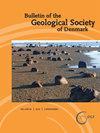Holocene development of Brabrand Fjord, eastern Jylland, Denmark.
IF 1
4区 地球科学
Q2 Earth and Planetary Sciences
引用次数: 0
Abstract
The Brabrand Sø area west of Aarhus in eastern Jylland, Denmark, was deglaciated about 18 000 to 17 000 years ago. Coring in the present-day lake area revealed Early Holocene stream deposits overlain by marine deposits. The area was transgressed by the sea at c. 8500 cal. years BP and a 12 km long, narrow fjord was formed. In the beginning, the fjord housed a species-poor marine or brackish-water fauna with molluscs Hydrobia sp. (mudsnail), Littorina littorea (winkle), Mytilus edulis (blue mussel) and Cerastoderma sp. (cockle). This phase was followed by a phase during which the fjord housed a species-rich fauna that included Ostrea edulis (European flat oyster) and Ruditapes decussatus (palourde clam). During this phase the salinity and summer water temperatures were higher than in present day Aarhus Bugt and we also see evidence for strong bottom currents. This phase was probably characterised by a fairly large tidal amplitude. Two radiocarbon ages of O. edulis shells of c. 6250 and 6700 cal. years BP indicate that such conditions peaked during the period of the Ertebølle culture. The high-salinity phase was followed by a phase with a more species-poor fauna, this phase was also characterised by a high sedimentation rate – a feature seen in other fjords in the region. We suggest that the shift could be due to a decrease in tidal amplitude. Brabrand Fjord was eventually transformed into a lake due to land uplift and closure of the connection to Aarhus Bugt due to longshore sediment transport but the timing of the transition from fjord to lake is still unknown.丹麦Jylland东部Brabrand峡湾的全新世开发。
丹麦Jylland东部奥胡斯以西的Brabrand Sø地区大约在18000年至17000年前冰川消融。在现在的湖区取芯显示了覆盖着海洋沉积物的全新世早期河流沉积物。该地区在英国石油公司8500年左右被海水入侵,形成了一个12公里长、狭窄的峡湾。一开始,峡湾是一个物种贫乏的海洋或半咸水动物群,包括软体动物Hydrobia sp.(muddenail)、Littorina littorea(winkle)、Mytilus edulis(蓝贻贝)和Cerastoderma sp.(cockle)。这一阶段之后是一个阶段,在此期间,峡湾拥有物种丰富的动物群,包括Ostrea edulis(欧洲扁平牡蛎)和Ruditapes decussatus(palourde蛤蜊)。在这一阶段,盐度和夏季水温都高于今天的奥胡斯Bugt,我们也看到了强大的底流的证据。这一阶段的特点可能是潮汐振幅相当大。约6250年和6700卡年BP的两个O.edulis贝壳的放射性碳年龄表明,这种情况在Ertebølle文化时期达到顶峰。高盐度阶段之后是一个物种贫乏的阶段,该阶段的特点也是沉积速率高——这是该地区其他峡湾的特点。我们认为这种变化可能是由于潮汐振幅的减小。布拉布兰德峡湾最终因陆地抬升而变成了一个湖泊,而与奥胡斯-布加特的连接因沿岸沉积物输送而关闭,但从峡湾到湖泊的过渡时间仍然未知。
本文章由计算机程序翻译,如有差异,请以英文原文为准。
求助全文
约1分钟内获得全文
求助全文
来源期刊

Bulletin of the Geological Society of Denmark
GEOSCIENCES, MULTIDISCIPLINARY-
CiteScore
2.80
自引率
16.70%
发文量
28
审稿时长
>12 weeks
期刊介绍:
The Bulletin publishes contributions of international interest in all fields of geological sciences on results of new work on material from Denmark, the Faroes and Greenland. Contributions based on other material may also be submitted to the Bulletin if the subject is of relevance for the geology of the area of primary interest.
 求助内容:
求助内容: 应助结果提醒方式:
应助结果提醒方式:


